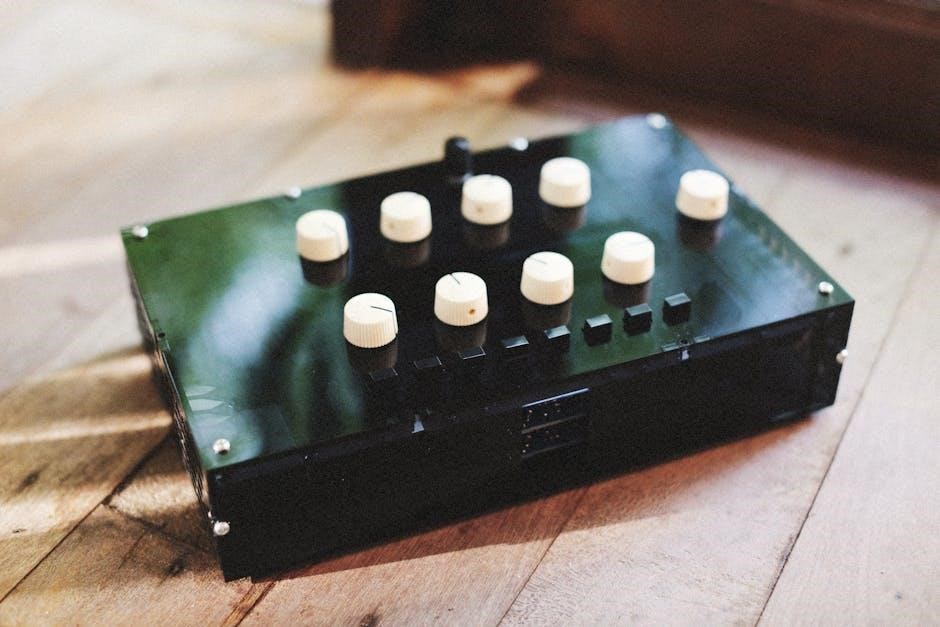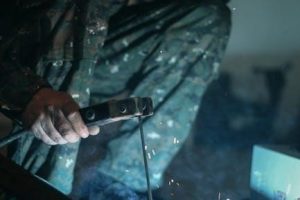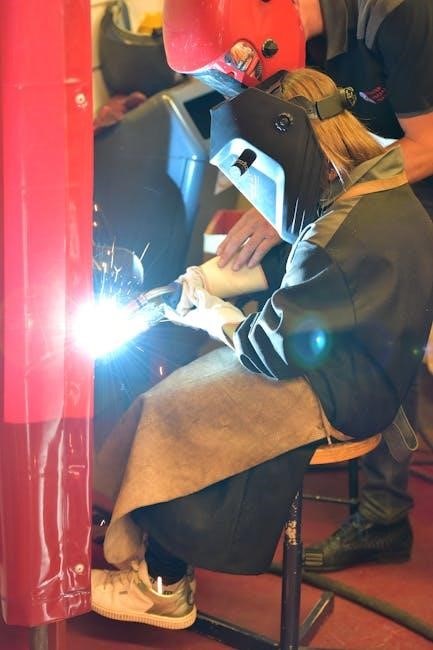feelings thermometer pdf

The Feelings Thermometer is a visual tool designed to help individuals measure and identify their emotional intensity. Rooted in Charles Darwin’s emotion studies, it enables users to express feelings effectively. Widely used by educators, therapists, and parents, this resource promotes emotional literacy and self-awareness, aiding in personal and professional settings. Its simplicity makes it accessible for all ages, fostering better emotional communication and regulation. Downloadable as a PDF, it offers a practical way to track and manage emotions, enhancing emotional intelligence and well-being.
What is a Feelings Thermometer?
A Feelings Thermometer is a visual tool designed to help individuals identify, express, and measure the intensity of their emotions. It typically consists of a scale, often ranging from 1 to 5, where 1 represents calm or happy feelings and 5 signifies intense emotions like anger or fury. This tool is widely used in educational, therapeutic, and personal settings to promote emotional awareness and regulation. It allows users to label their emotions and assess their emotional state, making it easier to develop coping strategies. The thermometer is simple, intuitive, and adaptable for different age groups, making it a versatile resource for fostering emotional literacy. By providing a clear framework, it helps individuals understand and manage their feelings more effectively, enhancing emotional intelligence and well-being. Its availability as a PDF makes it easily accessible for printing and sharing.
Benefits and Importance of Using a Feelings Thermometer
The Feelings Thermometer is a powerful tool for fostering emotional awareness and self-regulation. It helps individuals identify and label their emotions, making it easier to understand and manage feelings. By providing a visual scale, it enables users to assess emotional intensity, promoting self-awareness and emotional literacy. This tool is particularly beneficial for children, as it helps them develop a vocabulary for their emotions and learn coping strategies; In therapeutic settings, it aids in tracking emotional progress and identifying triggers. The thermometer also enhances communication in relationships by encouraging open discussions about feelings. Its simplicity and adaptability make it suitable for various age groups and contexts, including classrooms, workplaces, and personal use. By fostering emotional intelligence, the Feelings Thermometer supports overall well-being and helps individuals navigate emotional challenges more effectively. Its accessibility as a PDF further ensures widespread use and convenience.

Historical Background of the Feelings Thermometer

The Feelings Thermometer has roots in Charles Darwin’s emotion studies, as outlined in his book on expressions of emotions in humans and animals. This concept evolved into a practical tool for emotional assessment, aiding individuals in understanding and communicating their feelings effectively. Its historical development reflects the growing interest in emotional intelligence and mental health, making it a timeless resource for various applications today.
Charles Darwin’s Contributions to Emotion Studies
Charles Darwin’s groundbreaking work, The Expressions of the Emotions in Man and Animals, laid the foundation for understanding universal emotional expressions. His research identified consistent emotional responses across cultures and species, categorizing feelings like joy, grief, and anger. These findings highlighted the biological basis of emotions, providing a scientific framework for emotional awareness tools, including the Feelings Thermometer. Darwin’s insights into emotional intensity and its physical manifestations inspired the development of visual aids to measure and communicate emotions effectively. His work remains a cornerstone in the study of emotions, influencing modern tools like the Feelings Thermometer PDF, which helps users identify and express their emotional states with precision.
Evolution of the Feelings Thermometer Concept
The Feelings Thermometer concept has evolved from early emotion studies to a practical, user-friendly tool. Originating from Charles Darwin’s work on universal emotional expressions, the idea transitioned into visual aids for emotional measurement. Over time, educators and psychologists adapted the concept, creating structured scales to help individuals identify and communicate their feelings effectively. The development of printable worksheets and digital tools expanded its accessibility, making it a versatile resource for classrooms, therapy sessions, and personal use. Customization options, such as age-specific designs, further enhanced its applicability. Today, the Feelings Thermometer PDF is widely recognized as a valuable instrument for promoting emotional literacy, self-awareness, and regulation, aiding individuals of all ages in understanding and managing their emotions more effectively.

Design and Structure of the Feelings Thermometer
The Feelings Thermometer features a visual scale, typically ranging from “happy” to “furious,” with color-coded sections for easy emotional identification. Its simple layout and customizable design cater to various age groups, ensuring accessibility and effectiveness in measuring emotional intensity.
Visual Elements and Layout
The Feelings Thermometer incorporates vibrant visual elements, such as color-coded sections and facial expressions, to help users easily identify and express their emotions. The layout typically features a vertical or horizontal scale with numbered levels, ranging from “happy” to “furious,” allowing individuals to pinpoint their emotional state accurately. Each section is often paired with illustrations or emojis to enhance understanding, especially for children. The design is intentionally simple and intuitive, ensuring accessibility for all age groups. Customization options enable users to personalize colors and add additional elements like coping strategies or reflection sections, making the tool versatile for various needs. The combination of visual and tactile elements creates an engaging and effective method for emotional expression and regulation.
Understanding the Scale: From Happy to Furious
The Feelings Thermometer uses a simple, numbered scale to help users identify and express their emotional intensity. Typically ranging from 1 to 5, the scale starts with “happy” at the lowest level and progresses to “furious” at the highest. Each number corresponds to a specific emotional state, allowing individuals to pinpoint their feelings accurately. For example, level 1 might represent calmness or contentment, while level 5 signifies intense anger or frustration. This graduated approach enables users to articulate their emotions more effectively, making it easier to address and manage them. The scale is often accompanied by visual cues, such as facial expressions or color coding, to enhance understanding and accessibility for all ages. This tool is particularly useful in educational and therapeutic settings, helping individuals develop emotional awareness and regulation skills.
Customization Options for Different Age Groups
The Feelings Thermometer can be tailored to suit various age groups, ensuring its effectiveness for diverse users. For young children, the tool often features colorful visuals and simplified language, making it engaging and easy to understand. Older children and adolescents may benefit from more nuanced scales and emotional labels to capture complex feelings. Adults can use detailed versions with additional space for reflection and coping strategies. The PDF format allows for easy modifications, such as adding age-appropriate emojis or cultural adaptations. For instance, younger users might identify emotions through facial expressions, while adults can explore written descriptions. This flexibility ensures the tool remains relevant and impactful across all age groups, fostering emotional intelligence and self-regulation skills tailored to individual needs.

Applications of the Feelings Thermometer
The Feelings Thermometer is widely used in educational settings to enhance emotional awareness, in mental health and therapy to track emotional states, and in workplace environments to foster emotional intelligence. It also serves as a personal tool for self-regulation and is adaptable to various cultural and linguistic contexts.
Educational Use in Classrooms
The Feelings Thermometer is a valuable tool in educational settings, helping students identify and express their emotions effectively. Teachers use it to create a supportive classroom environment, fostering emotional awareness and self-regulation. The visual design simplifies complex emotions, making it accessible for all age groups. By integrating the thermometer into lesson plans, educators encourage open discussions about feelings, empowering students to articulate their emotions clearly. This resource is particularly beneficial for children who struggle to express themselves verbally. It also serves as a calm-down corner tool, helping students manage emotions during challenging moments. Available as a free PDF printable, it is widely used by social workers and educators to promote emotional literacy and resilience. Its adaptability allows it to be tailored to specific classroom needs, making it an essential asset for fostering a positive and emotionally intelligent learning environment.
Mental Health and Therapy
The Feelings Thermometer is widely used in mental health and therapy settings to help individuals identify, express, and manage their emotions. It serves as a powerful tool for therapists and counselors, enabling clients to articulate their emotional states effectively. By providing a visual scale, it simplifies the process of understanding emotional intensity, making it easier for individuals to communicate their feelings. This resource is particularly useful for those who struggle to verbalize their emotions, offering a clear framework for emotional exploration. Mental health professionals often incorporate the Feelings Thermometer into therapy sessions to promote emotional awareness and self-regulation. Its simplicity and adaptability make it an effective tool for fostering emotional literacy and supporting therapeutic goals. Available as a free PDF, it is a valuable resource for mental health practitioners aiming to enhance emotional understanding and well-being.
Workplace Emotional Intelligence
The Feelings Thermometer is a valuable tool for fostering emotional intelligence in the workplace. By helping employees and leaders identify and assess their emotional states, it promotes a culture of empathy and understanding. This resource is often used in team-building exercises, performance reviews, and stress management programs to enhance communication and collaboration. Managers can utilize the Feelings Thermometer to gauge team morale, address conflicts, and create a supportive work environment. It encourages self-awareness, a key component of emotional intelligence, allowing individuals to recognize and regulate their emotions. Regular use of the Feelings Thermometer can improve decision-making, reduce workplace stress, and foster a more inclusive and productive workplace culture. Its simplicity and accessibility make it an ideal tool for organizations aiming to boost employee well-being and performance. Available as a free PDF, it is a practical solution for workplace emotional intelligence initiatives.
Personal Use for Self-Regulation
The Feelings Thermometer is an excellent tool for personal use, empowering individuals to manage their emotions effectively. By identifying and labeling emotions, users can gain insights into their emotional states and develop strategies to regulate them. This resource is particularly useful for self-reflection, helping individuals recognize patterns in their feelings and respond to situations more mindfully. The thermometer’s visual scale allows users to assess emotional intensity, from calm to overwhelmed, and take appropriate steps to restore balance. Its simplicity makes it accessible for daily use, whether for personal growth or stress management. Available as a free PDF, the Feelings Thermometer is a practical and customizable tool for fostering self-awareness and emotional resilience. Regular use can lead to improved emotional regulation, enhancing overall well-being and quality of life.

Cultural and Linguistic Adaptability
The Feelings Thermometer is a versatile tool that can be adapted to suit diverse cultural and linguistic needs. Its visual design, often featuring recognizable facial expressions and color-coded scales, makes it accessible to individuals from various backgrounds. This adaptability ensures that users across different cultures can understand and relate to the emotions depicted. Additionally, the thermometer can be translated into multiple languages, breaking language barriers and making it inclusive for global use. Its universal appeal lies in its ability to transcend verbal communication, allowing users to express emotions non-verbally. This makes it an ideal resource for multicultural settings, such as international classrooms or workplaces, where diverse groups can benefit from its intuitive design. The availability of PDF templates further facilitates customization, ensuring the tool remains relevant and effective across different cultural contexts.

Step-by-Step Guide to Using the Feelings Thermometer
Introduce the tool, identify emotions, assess intensity, and develop coping strategies. Reflect on experiences to enhance emotional awareness and regulation, fostering a deeper understanding of feelings and behaviors.
Introducing the Tool to Users
Introducing the Feelings Thermometer begins with explaining its purpose as a visual aid for identifying and expressing emotions. Describe how the tool uses a scale to measure emotional intensity, from happy to furious, and emphasize its simplicity. Highlight its suitability for all ages, ensuring users understand it as a non-judgmental space for emotional exploration. Demonstrate how the tool’s design, with color-coded sections and facial expressions, helps users articulate their feelings more effectively. Encourage users to engage actively by pointing to or coloring the section that best represents their current emotional state. This introduction sets the foundation for open communication and emotional awareness, making the tool accessible and user-friendly for diverse audiences.

Identifying and Labeling Emotions
Identifying and labeling emotions is a crucial step in using the Feelings Thermometer effectively. Encourage users to start by recognizing their emotional state, whether it’s happiness, sadness, anger, or anxiety. Teach them to associate each emotion with specific feelings, such as joy, frustration, or calmness. Use the tool’s visual elements, like color-coded sections or facial expressions, to help users connect with their emotions visually. Guide them in naming their feelings using simple, clear language, fostering a deeper understanding of their emotional experiences. This process enhances self-awareness and emotional literacy, making it easier for users to communicate their feelings to others. Over time, this skill becomes intuitive, aiding in personal growth and emotional regulation.
Assessing Emotional Intensity
Assessing emotional intensity with the Feelings Thermometer involves evaluating the strength of one’s emotions on a structured scale. Typically ranging from 1 to 5 or 1 to 10, the scale allows users to rate their feelings, with higher numbers indicating more intense emotions. For example, a rating of 1 might represent calmness or happiness, while a rating of 5 could signify anger or frustration. This visual tool provides a clear framework for identifying where emotions fall on the spectrum, helping users better understand their emotional state. By consistently using the thermometer, individuals can develop greater awareness of their emotional fluctuations and improve their ability to regulate and manage their feelings effectively. This process fosters emotional intelligence and resilience, making it easier to navigate challenging emotional situations.

Developing Coping Strategies
Developing coping strategies is a crucial step in effectively managing emotions identified through the Feelings Thermometer. Once emotional intensity is assessed, individuals can explore tailored techniques to regulate their feelings. For example, deep breathing exercises, journaling, or engaging in physical activity can help reduce stress or anxiety. The thermometer’s visual scale encourages users to link specific emotions to actionable strategies, fostering a proactive approach to emotional well-being. By practicing these techniques regularly, individuals can build resilience and improve their ability to navigate challenging emotional situations. Customizable strategies ensure that the tool is adaptable to different age groups and contexts, making it a versatile resource for personal growth and emotional intelligence.
Reflecting on Emotional Experiences
Reflecting on emotional experiences is a vital step in fostering emotional growth and understanding. The Feelings Thermometer serves as a powerful tool for identifying patterns in emotional responses and understanding triggers. By revisiting past emotional states, individuals can gain insights into how specific situations influenced their feelings. This reflective process encourages self-awareness, allowing users to recognize recurring emotions and their underlying causes. Over time, reflection helps develop resilience and emotional intelligence, enabling individuals to manage emotions more effectively. Regularly reviewing emotional experiences also promotes personal growth, as it encourages individuals to learn from past reactions and adapt healthier responses. This practice is essential for improving mental well-being and fostering a deeper understanding of one’s emotional landscape.

Templates and Resources for the Feelings Thermometer
Various free Feelings Thermometer PDF templates are available online, offering customizable designs for different age groups and needs. Printable worksheets and digital tools provide flexible options for users to track emotions effectively.
Downloading the Feelings Thermometer PDF
Downloading the Feelings Thermometer PDF is a straightforward process. Many websites offer free printable templates designed for various purposes, including educational and therapeutic use. These resources are easily accessible and can be customized to suit different age groups and needs. Once downloaded, the PDF can be printed and laminated for durability, making it a long-lasting tool for emotional regulation. Additionally, some versions include velcro attachments, allowing users to mark their emotional state dynamically. The simplicity of the design ensures that both children and adults can benefit from this visual aid, helping them identify and manage their emotions effectively. By providing a clear and intuitive format, the Feelings Thermometer PDF becomes an invaluable asset for promoting emotional awareness and communication.
Digital Tools and Printable Worksheets
Digital tools and printable worksheets complement the Feelings Thermometer PDF, offering versatile options for emotional regulation. Printable worksheets provide a tactile experience, allowing users to manually track emotions and develop coping strategies. Many templates are customizable, catering to different age groups and needs. Digital tools, such as interactive thermometers, enable real-time tracking and sharing, making them ideal for therapeutic settings. These resources are widely available online, with many websites offering free downloads. They are particularly popular in educational environments, where they help students articulate emotions effectively. Both digital and printable formats ensure accessibility, making the Feelings Thermometer a flexible tool for fostering emotional literacy. Whether used at home or in professional settings, these resources empower individuals to manage emotions proactively and enhance overall well-being.
Free Resources and Where to Find Them
Accessing free Feelings Thermometer resources is straightforward, with numerous online platforms offering downloadable PDFs. Websites like Pinterest, Teachers Pay Teachers, and educational blogs provide a variety of templates tailored for different age groups. Many social work and mental health websites also offer complimentary worksheets designed to help users identify and express emotions. These resources are often customizable, allowing users to adapt them to specific needs. Additionally, some platforms offer laminated versions for durability, making them ideal for repeated use. Educators, therapists, and parents can easily find these tools by searching for “Feelings Thermometer PDF” or “emotional regulation worksheets.” These free resources are a valuable starting point for promoting emotional literacy and fostering self-awareness in both children and adults.
The Feelings Thermometer is a powerful and versatile tool for fostering emotional awareness and regulation. By providing a simple, visual method to identify and measure emotions, it has become an essential resource for educators, therapists, and individuals alike. Its adaptability across age groups and settings makes it a valuable asset for promoting emotional literacy. Whether used in classrooms, therapy sessions, or personal reflection, the Feelings Thermometer encourages open communication and self-awareness. As a freely available resource, it democratizes access to emotional intelligence tools, ensuring everyone can benefit from its insights. By helping users understand and manage their emotions, the Feelings Thermometer contributes to healthier relationships and a more emotionally intelligent society. Its enduring popularity is a testament to its effectiveness in navigating the complex world of human emotions.

















































